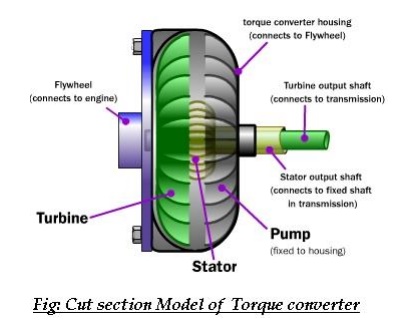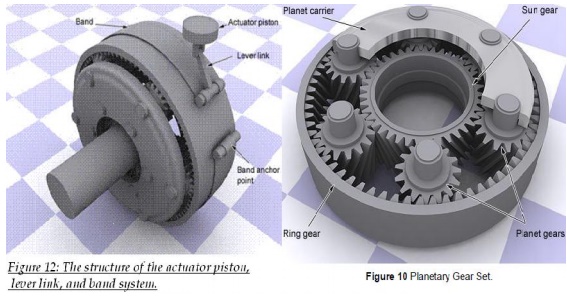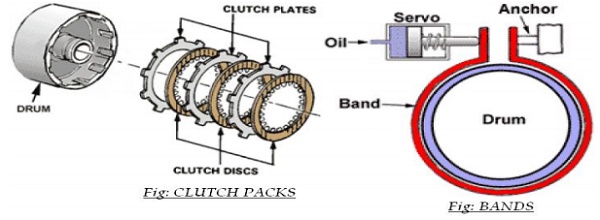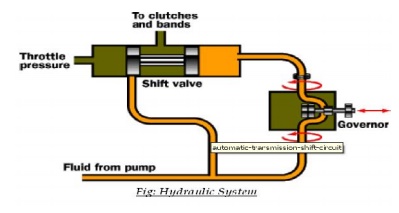Chapter: Mechanical : Automobile Engineering : Transmission Systems
Automatic Transmission
Automatic Transmission:
An automatic transmission (commonly "AT" or
"Auto") is an automobile gearbox that can change gear ratios
automatically as the vehicle moves, freeing the driver from having to shift
gears manually.
Automatic Transmission Modes:
In order to select the mode, the driver would have to move a
gear shift lever located on the steering column or on the floor next to
him/her. In order to select gears/modes the driver must push a button in
(called the shift lock button) or pull the handle (only on column mounted
shifters) out. In some vehicles position selector buttons for each mode on the
cockpit instead, freeing up space on the central console. Vehicles conforming
to U.S. Government standards must have the modes ordered P-R-N-D-L (left to
right, top to bottom, or clockwise). Prior to this, quadrant-selected automatic
transmissions often utilized a P-N-D-L-R layout, or similar. Such a pattern led
to a number of deaths and injuries owing to un-intentional gear miss-selection,
as well the danger of having a selector (when worn) jump into Reverse from Low
gear during engine braking maneuvers.
Automatic Transmissions have various modes depending on the
model and make of the transmission. Some of the common modes are:
Park Mode (P):-
This selection mechanically locks the transmission,
restricting the car from moving in any direction. A parking pawl prevents the
transmission—and therefore the vehicle—from
moving, although the vehicle's non-drive wheels may still spin freely. For this
reason, it is recommended to use the hand brake (or parking brake) because this
actually locks the (in most cases, rear) wheels and prevents them from moving.
This also increases the life of the transmission and the park pin mechanism,
because parking on an incline with the transmission in park without the parking
brake engaged will cause undue stress on the parking pin. An
efficiently-adjusted hand brake should also prevent the car from moving if a
worn selector accidentally drops into reverse gear during early morning
fast-idle engine warm ups.
Reverse (R):-
This puts the car into the reverse gear, giving the ability
for the car to drive backwards. In order for the driver to select reverse they
must come to a complete stop, push the shift lock button in (or pull the shift
lever forward in the case of a column shifter) and select reverse. Not coming
to a complete stop can cause severe damage to the transmission. Many modern
automatic gearboxes have a safety mechanism in place, which does to some extent
prevent (but doesn't completely avoid) inadvertently putting the car in reverse
when the vehicle is moving.
This mechanism usually consists of a solenoid-controlled
physical barrier on either side of the Reverse position, which is
electronically engaged by a switch on the brake pedal. Therefore, the brake
pedal needs to be depressed in order to allow the selection of reverse. Some
electronic transmissions prevent or delay engagement of reverse gear altogether
while the car is moving.
Neutral/No gear (N):-
This disconnects the transmission from the wheels so the car
can move freely under its own weight. This is the only other selection in which
the car can be started.
Drive (D):-
This allows the car to move forward and accelerate through its
range of gears. The number of gears a transmission has depends on the model,
but they can commonly range from 3, 4 (the most common), 5, 6 (found in VW/Audi
Direct Shift Gearbox), 7 (found in Mercedes 7G gearboxes, BMW M5 and VW/Audi
Direct Shift Gearbox) and 8 in the newer models of Lexus cars. Some cars when
put into D will automatically lock the doors or turn on the Daytime Running
Lamps.
Overdrive ([D], Od, Or A Boxed
D):-
This mode is used in some transmissions to allow early
Computer Controlled Transmissions to engage the Automatic Overdrive. In these
transmissions, Drive (D) locks the Automatic Overdrive off, but is identical
otherwise. OD (Overdrive) in these cars is engaged under steady speeds or low
acceleration at approximately 35-45 mph (approx. 72 km/h). Under hard
acceleration or below 35-45 mph, the transmission will automatically downshift.
Vehicles with this option should be driven in this mode unless circumstances
require a lower gear.
Second (2 or S):-
This mode limits the transmission to the first two gears, or
more commonly locks the transmission in second gear. This can be used to drive
in adverse conditions such as snow and ice, as well as climbing or going down
hills in the winter time. Some vehicles will automatically up-shift out of
second gear in this mode if a certain rpm range is reached, to prevent engine
damage.
First (1 or L):-
This mode locks the transmission in first gear only. It will
not accelerate through any gear range. This, like second, can be used during
the winter season, or for towing.
As well as the above modes there are also other modes,
dependent on the manufacturer and model. Some examples include:
D5:- In Hondas and Acuras equipped with 5-speed automatic
transmissions, this mode is used commonly for highway use (as stated in the
manual), and uses all five forward gears.
D4:- This mode is also found in Honda and Acura 4 or 5-speed
automatics and only uses the first 4 gears. According to the manual, it is used
for "stop and go traffic", such as city driving.
D3:- This mode is found in Honda and Acura 4-speed automatics
and only uses the first 3 gears. According to the manual, it is used for stop
& go traffic, such as city driving. This mode is also found in Honda and
Acura 5-speed automatics.
This is the manual selection of gears for automatics, such as
Porsche's Tiptronic. This feature can also be found in Chrysler and General
Motors products such as the Dodge Magnum and Pontiac G6. The driver can shift
up and down at will, by toggling the shift lever (console mounted) like a
semi-automatic transmission. This mode may be engaged either through a
selector/position or by actually changing gear (e.g. tipping the gear-down
paddles mounted near the driver's fingers on the steering wheel).
The predominant form of automatic transmission is
hydraulically operated, using a fluid coupling/ torque converter and a set of
planetary gear-sets to provide a range of torque multiplication.
Parts And Operation:-
A
hydraulic automatic transmission consists of the following parts:
·
Torque Converter/Fluid Coupling
·
Planetary Gear Set
·
Clutch packs & Bands
·
Valve Body
·
Hydraulic or Lubricating Oil

Torque Converter/Fluid Coupling: -Unlike a manual transmission
system, automatic transmission does not use a clutch to disconnect power from
the engine temporarily when shifting gears. Instead, a device called a torque
converter was invented to prevent power from being temporarily disconnected
from the engine and also to pre-vent the vehicle from stalling when the
transmission is in gear.
A fluid coupling/torque converter consists of a sealed chamber
containing two toroidal-shaped, vaned components, the pump and turbine,
immersed in fluid (usually oil). The pump or driving torus (the latter a
General Motors automotive term) is rotated by the prime mover, which is
typically an internal combustion engine or electric motor. The pump's motion
imparts a relatively complex centripetal motion to the fluid. Simplified, this
is a centrifugal force that throws the oil outwards against the coupling's housing,
whose shape forces the flow in the direction of the turbine or driven torus
(the latter also a General Motors term).
Here, Corolis force reaction transfers the angular fluid
momentum outward and across, applying torque to the turbine, thus causing it to
rotate in the same direction as the pump. The fluid leaving the center of the
turbine returns to the pump, where the cycle endlessly repeats. The pump
typically is connected to the flywheel of the engine—in fact,
the coupling's enclosure may be part of the flywheel proper, and thus is turned
by the engine's crankshaft. The turbine is connected to the input shaft of the
transmission. As engine speed increases while the transmission is in gear,
torque is transferred from the engine to the input shaft by the motion of the
fluid, propelling the vehicle. In this regard, the behavior of the fluid
coupling strongly resembles that of a mechanical clutch driving a manual
transmission.
A torque converter differs from a fluid coupling in that it
provides a variable amount of torque multiplication at low engine speeds,
increasing "breakaway" acceleration. This is accomplished with a
third member in the "coupling assembly" known as the stator, and by
altering the shapes of the vanes inside the coupling in such a way as to curve
the fluid's path into the stator. The stator captures the kinetic energy of the
transmission fluid in effect using the left-over force of it to enhance torque
multiplication.
Tiptronic transmission is a special type of automatic
transmission with a computer controlled automatic shift. The driver can switch
the transmission to manual mode, which lets her shift the gear at her wish
sequentially up (+) or down (-) without disengaging the clutch. This works just
like a manual transmission; however, it still uses a torque converter to
transfer power from the engine. Unfortunately, this is less efficient than a
manual transmission.

Planetary Gear-Set: - The automatic system for current
automobiles uses a planetary gear set instead of the traditional manual
transmission gear set. The planetary gear set contains four parts: sun gear,
planet gears, planet carrier, and ring gear. Based on this planetary set
design, sun gear, planet carrier, and ring gear spin centrifugally. By locking
one of them, the planetary set can generate three different gear ratios,
including one reverse gear, without engaging and disengaging the gear set. The
gear set is actuated by hydraulic servos controlled by the valve body,
providing two or more gear ratios.
Clutch Packs And Bands: - A clutch pack consists of
alternating disks that fit inside a clutch drum. Half of the disks are steel
and have splines that fit into groves on the inside of the drum.
`The other half have a friction material bonded to their
surface and have splines on the inside edge that fit groves on the outer
surface of the adjoining hub. There is a piston inside the drum that is
activated by oil pressure at the appropriate time to squeeze the clutch pack
together so that the two components become locked and turn as one.

A band is a steel strap with friction material bonded to the
inside surface. One end of the band is anchored against the transmission case
while the other end is connected to a servo. At the appropriate time hydraulic
oil is sent to the servo under pressure to tighten the band around the drum to
stop the drum from turning.
The bands come into play for manually selected gears, such as
low range or reverse, and operate on the planetary drum's circumference. Bands
are not applied when drive/overdrive range is selected, the torque being
transmitted by the sprag clutches instead.
The sun gear is connected to a drum, which can be locked by a
band. The ring gear is directly connected to the input shaft, which transfers
power from the engine. The planet carrier is connected to the output shaft,
which transfers power into the wheels.
Based on this design, when in neutral, both band and clutch
sets are released. Turning the ring gear can only drive planet gears but not
the planet carrier, which stays static if the car is not moving. The planet
gears drive the sun gear to spin freely. In this situation, the input shaft is
not able to transfer power to the output shaft. When shifting to 1st gear, the
band locks the sun gear by locking the drum. The ring gear drives the planet
carrier to spin. In this situation, the ring gear (input shaft) spins faster
than the planet carrier (output shaft).
To shift to higher gear, the band is released and the clutch
is engaged to force the sun gear and planet carrier (output shaft) to spin at
the same speed. The input shaft will also spin at the same speed as the output
shaft, which makes the car run faster than in 1st gear. Using a compound
planetary gear set generates more gear ratios with a special gear ratio,
over-drive gear whose gear ratio is small than 1.
This will make the gear shift smoother. Both the band and
clutch piston are pressurized by the hydraulic system. The part connecting the
band or clutches to the hydraulic system is called the shift valve, while the
one connecting the hydraulic system to the output shaft is called the governor.
The governor is a centrifugal sensor with a spring loaded
valve. The faster the governor spins, the more the valve opens. The more the
valve opens, the more the fluid goes through and the higher the pressure
applied on the shift valve. Therefore, each band and clutch can be pushed to
lock the gear based on a specific spin speed detected by the governor from the
output shaft. To make the hydraulic system work efficiently, a complex maze of
passages was designed to replace a large number of tubes. For modern cars, an
electronic con-trolled (computer controlled) solenoid pack is used to detect
throttle position, vehicle speed, engine speed, engine load, brake pedal
position, etc., and to automatically choose the best gear for a moving vehicle.
Principally, a type of device known as a sprag or roller
clutch is used for routine upshifts/downshifts. Operating much as a ratchet, it
transmits torque only in one direction, freewheeling or "overrunning"
in the other. The advantage of this type of clutch is that it eliminates the
sensitivity of timing a simultaneous clutch release/apply on two planetaries,
simply "taking up" the drivetrain load when actuated,and releasing
automatically when the next gear's sprag clutch assumes the torque transfer.


Valve Body: - Hydraulic control center that receives
pressurized fluid from a main pump operated by the fluid coupling/torque
converter. The pressure coming from this pump is regulated and used to run a
network of spring-loaded valves, check balls and servo pistons.
The valves use the pump pressure and the pressure from a
centrifugal governor on the output side (as well as hydraulic signals from the
range selector valves and the throttle valve or modulator) to control which
ratio is selected on the gearset; as the car and engine change speed, the
difference between the pressures changes, causing different sets of valves to
open and close.
Each of the many valves in the valve body has a specific
purpose and is named for that function. For example the 2-3 shift valves
activate the 2nd gear to 3rd gear up-shift or the 3-2 shift timing valve which
determines when a downshift should occur.
The hydraulic pressure controlled by these valves drives the
various clutch and brake band actuators, thereby controlling the operation of
the planetary gearset to select the optimum gear ratio for the current
operating conditions. However, in many modern automatic transmissions, the
valves are controlled by electro-mechanical servos which are controlled by the
Engine Management System or a separate transmission controller.
The most important valve and the one that you have direct
control over is the manual valve. The manual valve is directly connected to the
gear shift handle and covers and uncovers various passages depending on what
position the gear shift is placed in. When you place the gear shift in Drive,
for instance, the manual valve directs fluid to the clutch pack(s) that
activates 1st gear.
It also sets up to monitor vehicle speed and throttle position
so that it can determine the optimal time and the force for the 1 - 2 shifts.
On computer controlled transmissions, you will also have electrical solenoids
that are mounted in the valve body to direct fluid to the appropriate clutch
packs or bands under computer control to more precisely control shift points.
Hydraulic & Lubricating Oil: - A component called
Automatic Transmission Fluid (ATF) which is part of the transmission mechanism
provides lubrication, corrosion prevention, and a hydraulic medium to convey
mechanical power.
Primarily it is made of refined petroleum and processed to
provide properties that promote smooth power transmission and increase service
life. ATF is one of the parts of the automatic transmission that needs routine
service as the vehicle ages.
Related Topics